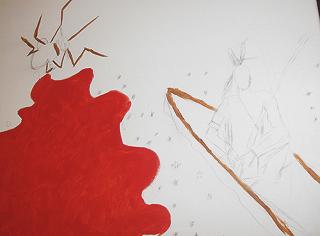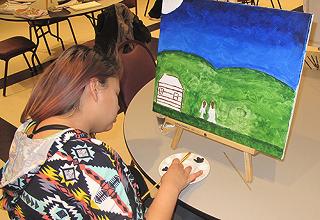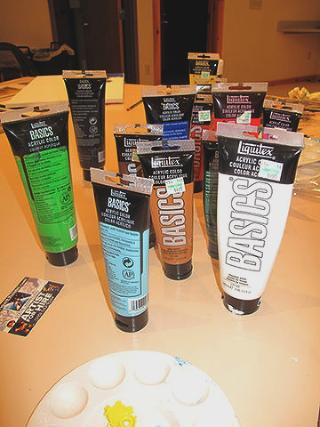 |
Canku Ota
|
 |
|
(Many Paths)
|
||
|
An Online Newsletter
Celebrating Native America
|
||
|
April 2016 - Volume
14 Number 4
|
||
|
|
||
|
Painting The Legends
|
||
|
by The Oneida Indian
Nation
|
||
And while these stories have certainly been told orally and written down (see Legend of the Mosquitoes and Autumn Color) several Oneida and other community members have put the legends to canvas. Beginning Feb. 16 and happening each Tuesday evening through March 15 the Oneida Indian Nation Shako:wi Cultural Center has been hosting a paint the legends class in the Nation's cookhouse. The top three paintings will be revealed at a reception and art show set for 3 to 7 p.m. on Friday, March 18, at Shako:wi. The paintings will be on display. The painting class is just one way Shako:wi reaches out to the Oneida and American Indian community. Jessica Farmer, cultural programs coordinator for the Oneida Nation Shako:wi Cultural Center, said other classes include creating dreamcatchers. Later this spring Shako:wi will offer a Flint Knife class with artist Elwood Webster (Wolf Clan). "Tonight we are painting the Big Dipper legend which some may know as the Fall Colors legend," said Jessica. "Some (participants) have painted in the past, for some this is brand new. Lisa (Latocha, Wolf Clan), who was convinced she didn't have any talent, told me that she probably couldn't do it. She took an art class before. Well, as you can see, she's done a very good job. I'm impressed with some of the talent we have." Jessica said she is surprised at how the participants are interpreting the legends. "It's native art. Everyone here is Native American and they are interpreting our own legends. I think that's really special to see because they're normally spoken. We shared the legends and they picked (painted) what they wanted to so there's a wide range. It's going to be nice to see the different interpretations." Weaving between stations and sorting through acrylics, Melissa McCann (Turtle Clan) was working on her piece depicting the Legend of the Mosquitoes. Melissa recalled having heard the legend 20 years ago and subsequently looking up the story, noting the variances between the oral version and those that were transcribed. "Each version would have a reference, and you would look that up, and that would have another reference. Before you know it you have four or five different stories – but it's all one. They're all really neat legends. They teach you something. "This has to do with the giant mosquito that is attacking the villagers and the warriors," she explained. Her piece showcases the giant bug coming down upon a warrior, touching him with his massive leg, as the warrior points toward the beast. "We're getting into a battle here and the water is rushing and the mosquito is ready to come on in and take over because the mosquito was quite strong." She added she was thankful that the Nation is offering such a class. "It sounded like fun. You paint the legend. You have a basis. You have a story, and everyone is taking that story and they have done something different with it. Yes, they have warriors. Yes, they have mosquitoes. But they're all different. For example Lisa (Latocha) painted a bunch of red and put a bunch of little mosquitoes. Once they finally killed the mosquito all these little ones came out whereas mine piece depicts the middle where the story is building up, where they're going to war." Next to Melissa was Teyekahli:yos Edwards (Wolf Clan) who took on the legend of the Big Dipper. "The story behind it is the three hunters who chased him (the bear) off the earth so I'm painting the actual constellation and then drawing the bear around the constellation. The cup itself represents the bear and the three stars behind it represent the three hunters." Teyekahli:yos has had experience painting before having taken classes with artist Birdy Burdick (Turtle Clan) and painting has been something she's always enjoyed. "I took classes with her when I was a little girl and I painted Corn Husk dolls, a water drum and a rattle, and I still have it. I wanted to learn about how to be a better painter. I only know the elementary, the basics of painting, and it's not much." As for concentrating on the Big Dipper itself Teyekahli:yos explained, "it is one of the part of the story that I can remember when I look up to the sky. I can see it. There's another part of the story when they shot him (the bear) with arrows, and it changed the leaves red, and that only happens once a year. This is what I think of when I think of this story." Local artist Stephen Wameling, who is assisting the class, began by doing a demo of different techniques for the class from painting a star field to demonstrating how to recreate fall foliage. Wameling received his fine arts degree from Munson-Williams-Proctor Institute in Utica and a degree in illustration from the Fashion Institute of Technology in New York City. "We had the class sketch out their idea and I try to help them paint it, help them turn out the way they envision it," Stephen said. "There is no right way to start off. Try it. Experiment with it. Try all different mediums and different techniques, and always look at artists." |
||||||||||
|
|
|
|
||
|
|
||
| Canku Ota is a free Newsletter celebrating Native America, its traditions and accomplishments . We do not provide subscriber or visitor names to anyone. Some articles presented in Canku Ota may contain copyright material. We have received appropriate permissions for republishing any articles. Material appearing here is distributed without profit or monetary gain to those who have expressed an interest. This is in accordance with Title 17 U.S.C. Section 107. | ||
|
Canku Ota is a copyright ©
2000 - 2016 of Vicki Williams Barry and Paul Barry.
|
||
 |
 |
|
|
The "Canku
Ota - A Newsletter Celebrating Native America" web site and
its design is the
|
||
|
Copyright ©
1999 - 2016 of Paul C. Barry.
|
||
|
All Rights Reserved.
|
||




